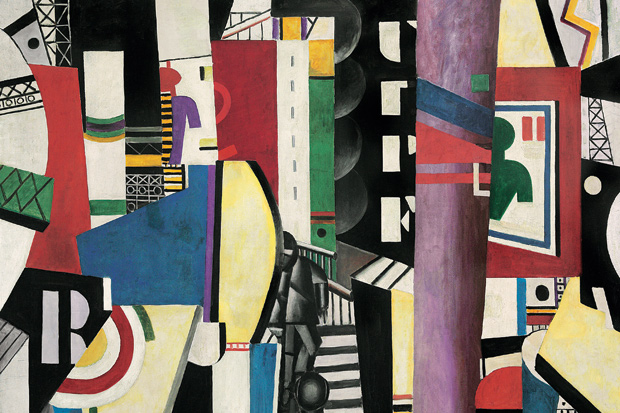In 1914 Fernand Léger gave a lecture about modern art. By then recognised as a leading Cubist artist, he had the year before signed up with the dealer Daniel-Henry Kahnweiler, who already represented Picasso and Braque.
‘If pictorial expression has changed, it is because modern life has necessitated it,’ Léger argued. ‘The existence of modern creative people is much more intense and more complex than that of people in earlier centuries…The view through the window of the railway carriage or the motorcar windshield, combined with the speed, has altered the customary look of things. A modern man registers a hundred times more sensory impressions than an 18th-century artist.’
However, Léger’s attempts to find a way of depicting in paint this overwhelming plethora of impressions were rudely interrupted shortly afterwards. In August 1914, at the age of 33, he was called up to fight on the Western Front, where he served as a sapper and stretcher bearer. Although he continued to sketch, mostly drawings of his fellow poilus in the trenches, he noted when he was invalided out of the conflict in 1917 that he had ‘spent three years without touching a brush’.
He returned with renewed passion and vigour to the task that he had set himself as an artist, of doing justice to modern life, epitomised for him by the newly mechanised urban environment of contemporary Paris. And in 1919 he unveiled the monumental ‘La Ville’ (The City), the most ambitious and vibrant of all his urban landscapes.
‘The City’ forms part of an exceptional collection of the artist’s works at the Philadelphia Museum of Art. The painting was the centrepiece of an exhibition Léger: Modern Art and the Metropolis at the museum before Christmas, which now comes, under a slightly different title, to Venice. The show, curated by Anna Vallye, displays not only more than 60 works by Léger himself, including films and designs for stage sets and costumes, from collections on both sides of the Atlantic, but also pieces by more than 30 other contemporary artists and architects.
By way of introduction, the exhibition’s first section, ‘The Metropolis before the Great War’, opens with an amusing self-portrait of Léger with his then dealer Léonce Rosenberg, two classic Léger tubular figures, grey-suited, in boater and bowler hat respectively, against an equally stylised backdrop of Venice, which they visited together in the 1920s.
There follow two of the artist’s key Cubist works from this period: one from his ‘Smoke on the Roofs’ series begun in 1911 and ‘Contrasting Forms’ (around 1912). These are accompanied by a superb line-up of other Cubist paintings by Robert Delaunay, Albert Gleizes, Frank Kupka and a stunning, chromatically layered interior with a view over a Paris square, ‘Still-life before an Open Window, Place Ravignan’, by Juan Gris.

‘The Painter of the City’ is then devoted to related and preparatory works for ‘The City’ itself. The impact of this post-Cubist picture is partly achieved by its sheer size and a cacophony of flatly applied primary colours. It is an assault on the eye in its artful arrangement of semi-recognisable elements — tall buildings, windows, railings, scaffolding, traffic signs, fragments of outsized lettering, glimpsed robotic figures descending and ascending steps — and of abstract forms, a bold realisation on canvas of Léger’s proposal in his 1914 lecture: ‘Contrast = dissonance, and hence a maximum expressive effect’. The picture offers not a literal image of the confusion and dynamism of the modern metropolis but a cogent correlative experience of the sensations that it can produce.
As the subsequent sections of the show — ‘Advertising’ and ‘The Performing Arts’ — demonstrate, Léger went on to try to replicate and extend, in posters, on film and in his designs for performances by the avant-garde Ballet Suédois, the vision that had informed ‘The City’.
Léger exerted a major influence on post-war graphic arts. A primary inspiration for ‘The City’ had been the Place Clichy in Paris with its immense advertising hoardings. This now fed back into Paris’s advertising art departments as they drew on Léger’s paintings to produce new, brilliantly coloured, geometric publicity images, leading Osbert Sitwell to point to the artist in 1928 as ‘the father of the contemporary French poster’.
Léger was also an early contributor to experimental cinema, doing the futuristic sets for Marcel L’Herbier’s L’inhumaine, creating Ballet Mécanique — starring animated household objects — and, with René Clair, making the surreal Entr’acte — all of which are continuously screened at this stimulating and entertaining exhibition.





Comments